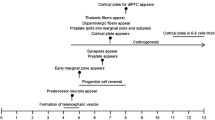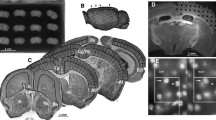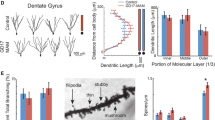Abstract
In the context of our current knowledge about schizophrenia, heuristic models of psychiatric disorders may be used to test the plausibility of theories developed on the basis of new emerging biological findings, explore mechanisms of schizophrenia-like phenomena, and develop potential new treatments. In a series of studies, we have shown that neonatal excitotoxic lesions of the rat ventral hippocampus (VH) may serve as a heuristic model. The model appears to mimic a spectrum of neurobiological and behavioral features of schizophrenia, including functional pathology in presumably critical brain regions interconnected with the hippocampal formation and targeted by antipsychotic drugs—the striatum/nucleus accumbens and the prefrontal cortex, and leads in adolescence or early adulthood to the emergence of abnormalities in a number of dopamine related behaviors. Moreover, our data show that even transient inactivation of the VH during a critical period of development, that produces subtle, if any, anatomical changes in the hippocampus, may be sufficient to disrupt normal maturation of the prefrontal cortex (and perhaps, other interconnected late maturing regions) and trigger behavioral changes similar to those observed in animals with the permanent excitotoxic lesion. These results represent a potential new model of aspects of schizophrenia without a gross anatomical lesion.
Similar content being viewed by others
References
Abi-Dargham, A., Gil, R., Krystal, J., Baldwin, R.M., Seibyl, J.P., Bowers, M., van Dyck, C.H., Charney, D.S., Innis, R.B. and Laruelle, M. (1998) “Increased striatal dopamine transmission in schizophrenia: confirmation in a second cohort”, Am. J. Psychiatry 155, 761–767.
Akbarian, S., Kim, J.J., Potkin, S.G., Hagman, J.O., Tafazzoli, A., Bunney, Jr, W.E. and Jones, E.G. (1995) “Gene expression for glutamic acid decarboxylase is reduced without loss of neurons in prefrontal cortex of schizophrenics”, Arch. Gen. Psychiatry 52, 258–266.
Al-Amin, H.A., Weinberger, D.R. and Lipska, B.K. (2000) “Exaggerated MK-801-induced motor hyperactivity in rats with the neonatal lesion of the ventral hippocampus”, Behav. Pharmacol. 11, 269–278.
Al-Amin, H.A., Weickert, C.S., Lillrank, S.M., Weinberger, D.R. and Lipska, B.K. (2001) “Delayed onset of enhanced MK-801-induced motor hyperactivity after neonatal lesions of the rat ventral hippocampus”, Biol. Psychiatry 49, 528–539.
Ashe, P., Chlan-Fourney, J., Juorio, A.V., Li, X-M. and Boulton, A.A. (1999) “Brain-derived neurotrophic factor mRNA in rats with neonatal ibotenic acid lesions of the ventral hippocampus”, Soc. Neurosci. Abstr., 63511.
Bachevalier, J., Alvarado, M.C. and Malkova, L. (1999) “Memory and socioemotional behavior in monkeys after hippocampal damage incurred in infancy or in adulthood”, Biol. Psychiatry 46(3), 329–339.
Beauregard, M. and Bachevalier, J. (1996) “Neonatal insult to the hippocampal region and schizophrenia: a review and a putative animal model”, Can. J. Psychiatry 41(7), 446–456.
Becker, A., Grecksch, G., Bernsteinn, H-G., Hollt, V. and Bogerts, B. (1999) “Social behavior in rats lesioned with ibotenic acid in the hippocampus: quantitative and qualitative analysis”, Psychopharmacology 144, 333–338.
Bertolino, A., Saunders, R.C., Mattay, V.S., Bachevalier, J., Frank, J.A. and Weinberger, D.R. (1997) “Altered development of prefrontal neurons in rhesus monkeys with neonatal mesial temporo-limbic lesions: A proton magnetic resonance spectroscopic imaging study”, Cereb. Cortex 7, 740–748.
Bertolino, A., Callicott, J.H., Elman, I., Mattay, V.S., Tedeschi, G., Frank, J.A., Breier, A. and Weinberger, D.R. (1998) “Regionally specific neuronal pathology in untreated patients with schizophrenia: a proton magnetic resonance spectroscopic imaging study”, Biol. Psychiatry 43, 641–648.
Bertolino, A., Breier, A., Callicott, J.H., Adler, C., Mattay, V.S., Shapiro, M., Frank, J.A., Pickar, D. and Weinberger, D.R. (2000) “The relationship between dorsolateral prefrontal neuronal N-acetylaspartate and evoked release of striatal dopamine in schizophrenia”, Neuropsychopharmacology 22, 125–132.
Bertolino, A., Roffman, J.L., Lipska, B.K., Van Gelderen, P., Olson, A., Weinberger, D.R., “Postpubertal emergence of prefrontal neuronal deficits and altered dopaminergic behaviors in rats with neonatal hippocampal lesions”, Cereb. Cortex, In press.
Black, M.D., Lister, S., Hitchcock, J.M., Giersbergen, P. and Sorensen, S.M. (1998) “Neonatal hippocampal lesion model of schizophrenia in rats: sex differences and persistence of effects into maturity”, Drug Dev. Res. 43, 206–213.
Bogerts, B., Ashtar, M., Degreef, G., Alvir, J.M.J., Bilder, R.M. and Lieberman, J.A. (1990) “Reduced temporal limbic structure volumes on magnetic resonance images in first-episode schizophrenia”, Psychiatry Res. Neuroimaging 35, 1–13.
Brake, W.G., Sullivan, R.M., Flores, G., Srivastava, L. and Gratton, A. (1999) “Neonatal ventral hippocampal lesions attenuate the nucleus accumbens dopamine response to stress: an electrochemical study in the rat”, Brain Res. 831, 25–32.
Breier, A., Su, T.P., Saunders, R., Carson, R.E., Kolachana, B.S., de Bartolomeis, A., Weinberger, D.R., Weisenfeld, N., Malhotra, A.K., Eckelman, W.C. and Pickar D. (1997) “Schizophrenia is associated with elevated amphetamine-induced synaptic dopamine concentrations: evidence from a novel positron emission tomography method”, Proc. Natl Acad. Sci. USA 94, 2569–2574.
Carr, D.B. and Sesack, S.R. (1996) “Hippocampal afferents to the rat prefrontal cortex: Synaptic targets and relation to dopaminergic terminals”, J. Comp. Neurol. 369, 1–15.
Castner, S.A., Al-Tikriti, M.S., Baldwin, R.M., Seibyl, J.P., Innis, R.B. and Goldman-Rakic, P.S. (2000) “Behavioral changes and [123I]IBZM equilibrium SPECT measurement of amphetamine-induced dopamine release in rhesus monkeys exposed to subchronic amphetamine”, Neuropsychopharmacology 22, 4–13.
Chambers, R.A., Moore, J., McEvoy, J.P. and Levin, E.D. (1996) “Cognitive effects of neonatal hippocampal lesions in a rat model of schizophrenia”, Neuropsychopharmacology 15, 587–594.
Costall, B. and Naylor, R.J. (1995) “Animal neuropharmacology and its prediction of clinical response”, In: Hirsch, S.R. and Weinberger, D.R., eds, Schizophrenia (Blackwell, Oxford), pp. 401–424.
Duncan, G.E., Sheitman, B.B. and Lieberman, J.A. (1999) “An integrated view of pathophysiological models of schizophrenia”, Brain Res. Brain Res. Rev. 29, 250–264.
Eastwood, S.L. and Harrison, P.J. (1998) “Hippocampal and cortical growth-associated protein-43 messenger RNA in schizophrenia”, Neuroscience 86, 437–448.
Eastwood, S.L., McDonald, B., Burnet, P.W., Beckwith, J.P., Kerwin, R.W. and Harrison, P.J. (1995) “Decreased expression of mRNAs encoding non-NMDA glutamate receptors GluR1 and GluR2 in medial temporal lobe neurons in schizophrenia”, Brain Res. Mol. Brain Res. 29, 211–223.
Eastwood, S.L., Burnet, P.W. and Harrison, P.J. (1997) “GluR2 glutamate receptor subunit flip and flop isoforms are decreased in the hippocampal formation in schizophrenia: a reverse transcriptase-polymerase chain reaction (RT-PCR) study”, Brain Res. Mol. Brain Res. 44, 92–98.
Ellenbroek, B.A. and Cools, A.R. (1990) “Animal models with construct validity for schizophrenia”, Behav. Pharmacol. 1, 469–490.
Falkai, P. and Bogerts, B. (1986) “Cell loss in the hippocampus of schizophrenics”, Eur. Arch. Psychiatry Neurol. Sci. 236, 154–161.
Feldpausch, D.L., Needham, L.M., Stone, M.P., Althaus, J.S., Yamamoto, B.K., Svensson, K.A. and Merchant, K.M. (1998) “The role of dopamine D4 receptor in the induction of behavioral sensitization to amphetamine and accompanying biochemical and molecular adaptations”, J. Pharmacol. Exp. Ther. 286, 497–508.
Flores, G., Barbeau, D., Quirion, R. and Srivastava, L.K. (1996) “Decreased binding of dopamine D3 receptors in limbic subregions after neonatal bilateral lesion of rat hippocampus”, J. Neurosci. 16, 2020–2026.
Gambarana, C., Masi, F., Tagliamonte, A., Scheggi, S., Ghiglieri, O. and De Montis, M.G. (1999) “A chronic stress that impairs reactivity in rats also decreases dopaminergic transmission in the nucleus accumbens: a microdialysis study”, J. Neurochem. 72(5), 2039–2046.
Glantz, L.A. and Lewis, D.A. (2000) “Decreased dendritic spine density on prefrontal cortical pyramidal neurons in schizophrenia”, Arch. Gen. Psychiatry 57, 65–73.
Grecksch, G., Bernstein, H.G., Becker, A., Hollt, V. and Bogerts, B. (1999) “Disruption of latent inhibition in rats with postnatal hippocampal lesions”, Neuropsychopharmacology 20, 525–532.
Hori, T., Subramaniam, S., Carli, M., Srivastava, L.K. and Quirion, R. (1999) “Effects of repeated phencyclidine administration on locomotor activity and forced swimming test in rats with neonatal ventral hippocampal lesions”, Soc. Neurosci. Abstr., 6358.
Imperato, A., Obinu, M.C., Carta, G., Mascia, M.S., Casu, M.A. and Gessa, G.L. (1996) “Reduction of dopamine release and synthesis by repeated amphetamine treatment: role in behavioral sensitization”, Eur. J. Pharmacol. 317, 231–237.
Jay, T.M., Glowinski, J. and Thierry, A.-M. (1989) “Selectivity of the hippocampal projection to the prelimbic area of the prefrontal cortex in the rat”, Brain Res. 505, 337–340.
Jeste, D.V. and Lohr, J.B. (1989) “Hippocampal pathologic findings in schizophrenia: a morphometric study”, Arch. Gen. Psychiatry 46, 1019–1024.
Kornetsky, C. and Markowitz, R. (1978) “Animal models of schizophrenia”, In: Lipton, M.A., DiMascio, A. and Killam, K.F., eds, Psychopharmacology: A Generation of Progress (Raven Press, New York), pp 583–593.
Laruelle, M., Abi-Dargham, A., van Dyck, C.H., Gil, R., D'Souza, C.D., Erdos, J., McCance, E., Rosenblatt, W., Fingado, C., Zoghbi, S.S., Baldwin, R.M., Seibyl, J.P., Krystal, J.H., Charney, D.S. and Innis, R.B. (1996) “Single photon emission computerized tomography imaging of amphetamine-induced dopamine release in drug-free schizophrenic subjects”, Proc. Natl Acad. Sci. USA 93, 9235–9240.
Lee, C.J., Binder, T., Lipska, B.K., Zhu, Y., Weinberger, D.R., Nakabeppu, Y. and Robertson, G.S. (1998) “Neonatal ventral hippocampal lesions produce an elevation of Δ-FosB-like protein(s) in the rodent neocortex”, Soc. Neurosci. Abstr. 24, 489.
Lieberman, J.A., Sheitman, B.B. and Kinon, B.J. (1997) “Neurochemical sensitization in the pathophysiology of schizophrenia: deficits and dysfunction in neuronal regulation and plasticity”, Neuropsychopharmacology 17(4), 205–229.
Lipska, B.K. and Weinberger, D.R. (1993) “Delayed effects of neonatal hippocampal damage on haloperidol-induced catalepsy and apomorphine-induced stereotypic behaviors in the rat”, Dev. Brain Res. 75, 13–222.
Lipska, B.K. and Weinberger, D.R. (1994a) “Subchronic treatment with haloperidol or clozapine in rats with neonatal excitotoxic hippocampal damage”, Neuropsychopharmacology 10, 199–205.
Lipska, B.K. and Weinberger, D.R. (1994b) “Gonadectomy does not prevent novelty- or drug-induced hyperresponsiveness in rats with neonatal excitototxic hippocampal damage”, Dev. Brain Res. 78, 253–258.
Lipska, B.K. and Weinberger, D.R. (1995) “Genetic variation in vulnerability to the behavioral effects of neonatal hippocampal damage in rats”, Proc. Natl Acad. Sci. USA 92, 8906–8910.
Lipska, B.K. and Weinberger, D.R. (2000) “To model a psychiatric disorder in animals: schizophrenia as a reality test”, Neuropsychopharmacology 23, 223–239.
Lipska, B.K., Jaskiw, G.E. and Weinberger, D.R. (1993) “Post-pubertal emergence of hyperresponsiveness to stress and to amphetamine after neonatal hippocampal damage: a potential animal model of schizophrenia”, Neuropsychopharmacology 9, 67–75.
Lipska, B.K., Swerdlow, N.R., Geyer, M.A., Jaskiw, G.E., Braff, D.L. and Weinberger, D.R. (1995a) “Neonatal excitotoxic hippocampal damage in rats causes postpubertal changes in prepulse inhibition of startle and its disruption by apomorphine”, Psychopharmacology 122, 35–43.
Lipska, B.K., Chrapusta, S.J., Egan, M.F. and Weinberger, D.R. (1995b) “Neonatal excitotoxic ventral hippocampal damage alters dopamine response to mild chronic stress and haloperidol treatment”, Synapse 20, 125–130.
Lipska, B.K., Al-Amin, H.A. and Weinberger, D.R. (1998a) “Excitotoxic lesions of the rat medial prefrontal cortex: effects on abnormal behaviors associated with neonatal hippocampal damage”, Neuropsychopharmacology 19, 451–464.
Lipska, B.K., Khaing, Z.Z., Lerman, D.N. and Weinberger, D.R. (1998b) “Neonatal damage of the rat ventral hippocampus reduces expression of a dopamine transporter”, Soc. Neurosci. Abstr. 24, 365.
Lipska, B.K., Kolb, B., Halim, N. and Weinberger, D.R. (2001) “Synaptic abnormalities in prefrontal cortex and nucleus accumbens of adult rats with neonatal hippocampal damage”, Schizophr. Res. 49, 47.
Lipska, B.K., Halim, N.D., Segal, P.N. and Weinberger, D.R. (2002) “Effects of reversible inactivation of the neonatal ventral hippocampus on behavior in the adult rat”, J. Neurosci. 22, 2835–2842.
Lipska, B.K., Aultman, J.M., Verma, A., Weinberger, D.R., Moghaddam, B. (2002) “Neonatal damage of the ventral hippocampus impairs working memory in the rat”, Neuropsychopharmacology 27, 47–54.
McKinney, W.T. and Moran, E.C. (1981) “Animal models of schizophrenia”, Am. J. Psychiatry 138, 478–483.
Meng, Z.H., Feldpaush, D.L. and Merchant, K.M. (1998) “Clozapine and haloperidol block the induction of behavioral sensitization to amphetamine and associated genomic responses in rats”, Brain Res. Mol. Brain Res. 61(1–2), 39–50.
Murray, R.M. and Lewis, S.W. (1987) “Is schizophrenia a neurodevelopmental disorder?”, Br. Med. J. 295, 681–682.
Nestler, E.J. and Aghajanian, G.K. (1997) “Molecular and cellular basis of addiction”, Science 278, 58–63.
O'Donnell, P., Lewis, B.L., Lerman, D., Weinberger, D.R., Lipska, B.K., “Effects of neonatal hippocampal lesions on prefrontal cortical pyramidal cell responses to VTA stimulation”, Cereb. Cortex, In press.
Robinson, T.E. and Kolb, B. (1997) “Persistent structural modifications in nucleus accumbens and prefrontal cortex neurons produced by previous experience with amphetamine”, J. Neurosci. 17, 8491–8497.
Roffman, J.L., Lipska, B.K., Bertolino, A., Van Gelderen, P., Olson, A.W., Khaing, Z.Z. and Weinberger, D.R. (2000) “Local and downstream effects of excitotoxic lesions in the rat medial prefrontal cortex on in vivo 1H-MRS signals”, Neuropsychopharmacology 22, 430–439.
Sams-Dodd, F., Lipska, B.K. and Weinberger, D.R. (1997) “Neonatal lesions of the rat ventral hippocampus result in hyperlocomotion and deficits in social behaviour in adulthood”, Psychopharmacology 132, 303–310.
Saunders, R.C., Kolachana, B.S., Bachevalier, J. and Weinberger, D.R. (1998) “Neonatal lesions of the temporal lobe disrupt prefrontal cortical regulation of striatal dopamine”, Nature 393, 169–171.
Schroeder, H., Grecksch, G., Becker, A., Bogerts, B. and Höllt, V. (1999) “Alterations of the dopaminergic and glutamatergic neurotransmission in adult rats with postnatal ibotenic acid hippocampal lesion”, Psychopharmacology 145, 61–66.
Sershen, H., Harsing, L.G., Lipska, B.K. and O'Donnell, P. (2002) “High Gly: Role of glycine transporter in regulation of NMDA function (Abstract)”, Winter Conf. Brain Res. Snowmass, Colorado.
Spanagel, R. and Weiss, F. (1999) “The dopamine hypothesis of reward: past and current status”, Trends Neurosci. 22, 521–527.
Suddath, R.L., Christisin, G.W., Torrey, E.F., Casanova, M. and Weinberger, D.R. (1990) “Anatomical abnormalities in the brains of monozygotic twins discordant for schizophrenia”, N. Eng. J. Med. 322, 789–794.
Steiner, H. and Gerfen, C.R. (1998) “Role of dynorphin and enkephalin in the regulation of striatal output pathways and behavior”, Exp. Brain Res. 123, 60–76.
Vanderschuren, L.J., Schmidt, E.D., De Vries, T.J., Van Moorsel, C.A., Tilders, F.J. and Schoffelmeer, A.N. (1999) “A single exposure to amphetamine is sufficient to induce long-term behavioral, neuroendocrine, and neurochemical sensitization in rats”, J. Neurosci. 19, 9579–9586.
Wan, R.Q. and Corbett, R. (1997) “Enhancement of postsynaptic sensitivity to dopaminergic agonists induced by neonatal hippocampal lesions”, Neuropsychopharmacology 16, 259–268.
Wan, R-Q., Giovanni, A., Kafka, S.H. and Corbett, R. (1996) “Neonatal hippocampal lesions induced hyperresponsiveness to amphetamine: behavioral and in vivo microdialysis studies”, Behav. Brain Res. 78, 211–223.
Wan, R.Q., Hartman, H. and Corbett, R. (1998) “Alteration of dopamine metabolites in CSF and behavioral impairments induced by neonatal hippocampal lesions”, Physiol. Behav. 65, 429–436.
Weinberger, D.R. (1987) “Implications of normal brain development for the pathogenesis of schizophrenia”, Arch. Gen. Psychiatry 44, 660–669.
Weinberger, D.R. (1999) “Cell biology of the hippocampal formation in schizophrenia”, Biol. Psychiatry 45, 395–402.
Author information
Authors and Affiliations
Corresponding author
Rights and permissions
About this article
Cite this article
Lipska, B.K., Weinberger, D.R. A neurodevelopmental model of schizophrenia: Neonatal disconnection of the hippocampus. neurotox res 4, 469–475 (2002). https://doi.org/10.1080/1029842021000022089
Received:
Revised:
Accepted:
Issue Date:
DOI: https://doi.org/10.1080/1029842021000022089




